The birth story of a bird is amazing to many people. They start as pretty little eggs securely hatching in a nest. How long does it take for bird eggs to hatch? Well, the incubation period of these eggs varies greatly between species. On average, this period is between 10 and 30 days. Most of the time, the mama bird warms her eggs by sitting on them while the papa bird provides food for her. We’ve got all you need to know about the nests and incubation period of your favorite birds.
What’s First? The Chicken Or The Egg?
All birds start the same way. They are all little eggs before they hatch and are ready to face the world. Incubation begins after the egg is laid. This means there is heat added by the parent, usually by molting feathers to expose the lower abdomen’s skin. The species of the bird depends on the length of the incubation period. So, why does a chicken egg not turn into a baby chick? This is because eggs are very sensitive to changes in the temperature. If the temperature is too low or too high, an embryo will not develop correctly. The parents must pay a lot of attention to their incubation period.

Baltimore Oriole
The Baltimore Oriole flies to the north during the warmer months to lay their eggs. They like to build their nest in the middle of a tree full of leaves. You’ll often see these birds nesting high in your tree or in open wood areas. The male oriole will guard the nest while the female builds it. This nest is made from things in nature like bark, grass and sometimes horsehair or twine.
The nest gently hangs from the branch. It’s usually about four inches deep. It will have an opening at the top with a bigger chamber at the bottom of the nest for the eggs.
Baltimore Oriole Eggs: Appearance, and How Long Until They Hatch
The Baltimore Oriole will on average lay about seven eggs. They only have one brood each season. These eggs are grey, may have spots, and may even look a little lavender. They usually range from about 0.8 to one inches long and 0.6 to 0.7 inches wide. These eggs are incubated for up to 14 days. Once they hatch, the little orioles are dependent on their mama and papa birds. Their eyes aren’t open yet, so they need all the help they can get.

Canada Geese
Canada geese are found all over in Canada and North American during their breeding season. They like to make a nest between February and April in these areas. They’ll build their nest close to the water, but on raised ground. This helps them to have great visibility of any predators in the area.
Canada geese make their nest from natural materials like moss, grass, and lichens. They often line the inside with the mother’s feathers. They return every year to the same site to build a nest. They also stay with the same partner their entire lives.
Canada Geese Eggs: Appearance, and How Long Until They Hatch
These birds will usually lay between two and eight geese eggs. They are large and creamy white. The length of a Canada geese egg is a little over three inches, and the width is a little over two inches. Their incubation period lasts up to 28 days. The female warms the eggs by sitting on them while her mate is nearby to protect them. Once the hatchlings are born, their eyes are open and they are covered in little yellow feathers. They need their parents, but can survive up to two days without them around to feed the hatchlings.
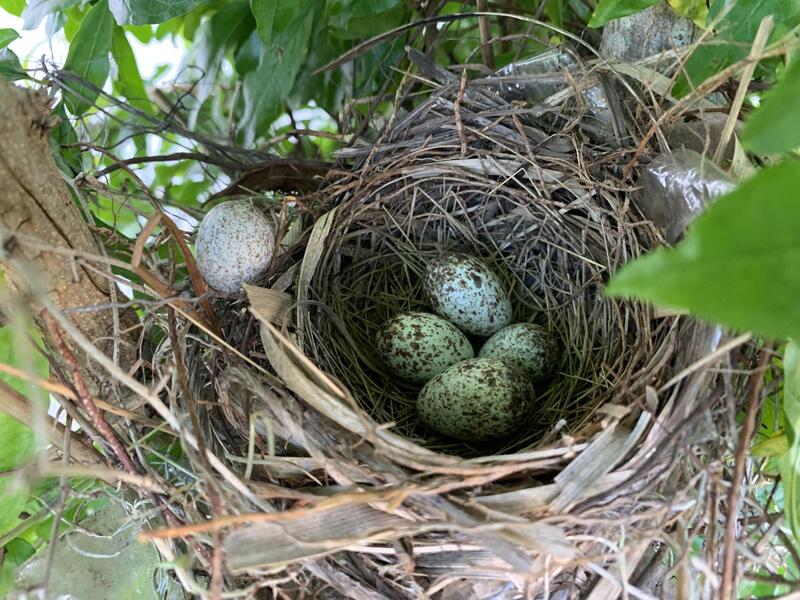
Northern Cardinal
Northern Cardinals research the best place to lay their eggs by flying around to different sites. They usually choose a fork in a branch or a shrub. They like to build a nest as small as five feet from the ground and as high as 50 feet from the ground.
The male cardinal works to bring his mama bird the perfect materials for her nest. She likes to build with grass, pine needles, twigs, leaves, and bark. It will often take her over a week to build the next. It’s usually about four inches wide and two inches tall.
Northern Cardinal Eggs: Appearance, and How Long Until They Hatch
The female bird will often have two broods of eggs a year. She usually lays up to five eggs. These eggs are greenish-white or grayish-white and have speckles. They are about one inch long by 0.8 inches wide. The mama bird will sit on them from seven to 13 days. Once the baby northern cardinal is hatched, their eyes are not yet open and they only have a few little feathers.
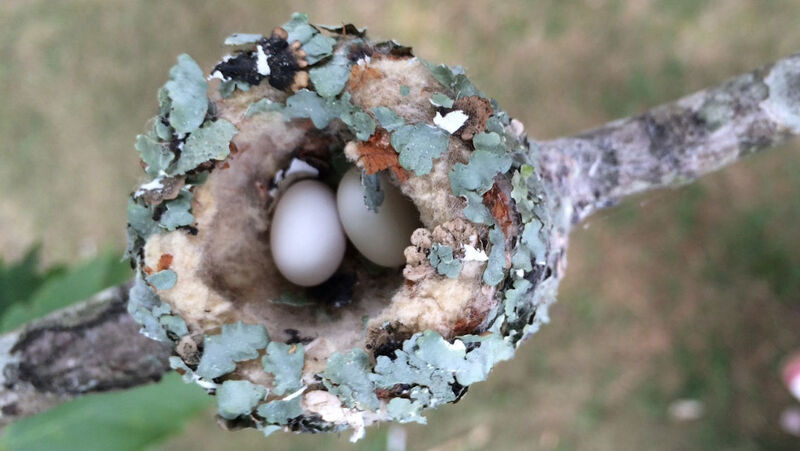
Ruby Throated Hummingbird
The Ruby Throated Hummingbird likes to build a nest in an area with lots of trees. You’ll see them in your backyard many times. They choose a branch that is a few feet from the ground. Their nests are so tiny that many people never spot them. A hummingbird’s nest might be only two inches wide. They usually use thistle, spider silk, and grass to make their nest. Sometimes they will add moss and dead leaves to the outside of it. The mama hummingbird makes the nest on her own.
Ruby Throated Hummingbird Eggs: Appearance, and How Long Until They Hatch
The mama Ruby Throated Hummingbird will usually only two eggs, but she will sometimes have two of these a year. She can even start building another nest for another two eggs while feeding the first hatchlings. Her eggs are small, about 0.6 inches long to 0.3 inches wide. They are about the size of a pea. These eggs are white. She will sit on her babies for about 12 to 14 days. When a baby Ruby Throated Hummingbird is born, their eyes are closed and they only have two streaks of fur down their back.

American Robins
Robins lay their eggs a little different than most birds. They choose to lay eggs after they eat their breakfast of earthworms. They hunt for worms before sunrise then lay the eggs. They only lay one egg a day then stop at four in all. They often build a nest in the lower part of a tree. Sometimes they will even put a nest in a gutter or your eaves.
American Robin Eggs: Appearance, and How Long Until They Hatch
They will then sit on their eggs for up to 14 days. The female doesn’t leave her eggs for very long. She rotates the eggs a few times a day with her bill. The male protects her and the nest. These eggs are usually about one inch long and 0.8 inches wide. They are a beautiful, bright blue color. After the birds hatch, both parents protect them. A baby robin will leave the nest in about two weeks.
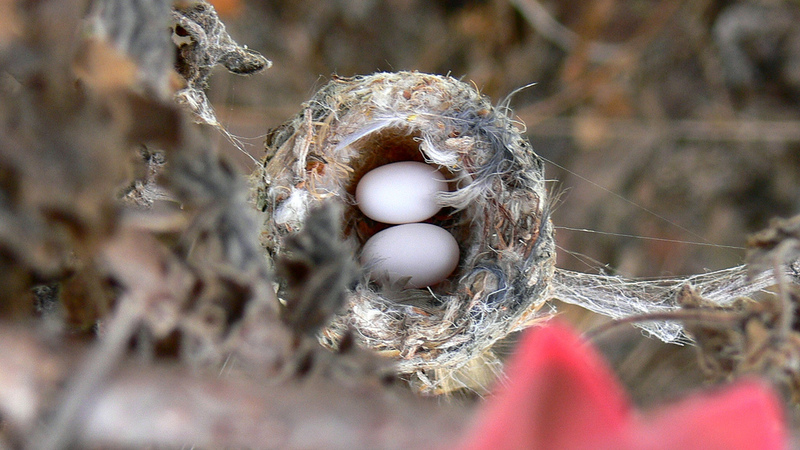
Anna’s Hummingbird
Anna’s Hummingbirds like to build their tests high in a tree or in a shrub. They like to be close to their sources of food. Their tiny nests are only about one inch tall.
The hummingbird takes about a week to build its nest. The female Anna’s Hummingbird does all of the work with leaves, cattails, and small feathers.
Anna’s Hummingbird Eggs: Appearance, and How Long Until They Hatch
Anna’s Hummingbirds lay about two eggs each time. They can do this a few times a year. These tiny eggs resemble a pea at only 0.6 inches long and 0.3 inches wide. The female will incubate them for about 16 days. These baby hummingbirds only have a few down and their eyes are closed.
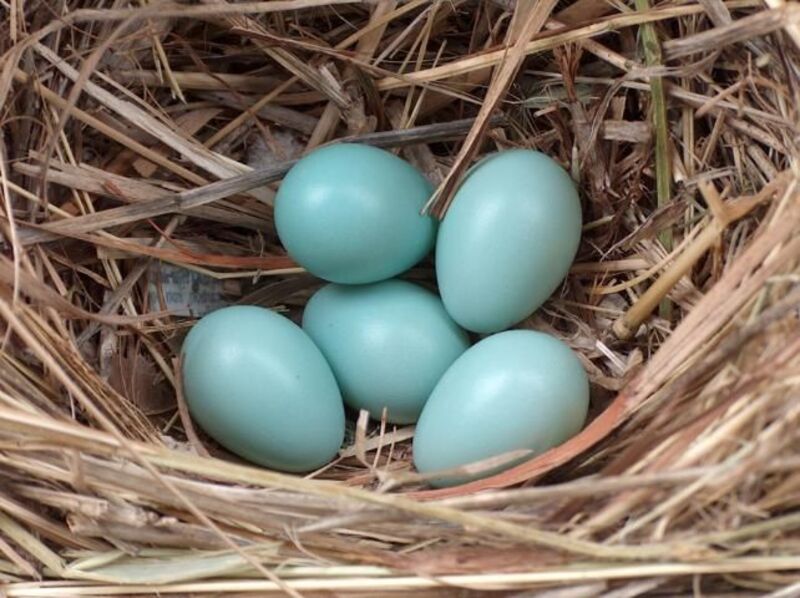
European Starling
Starlings love to nest together. The male will construct part of the nest then sing until a mate answers him. When the female decides she wants to join one of these singers, she will come in to finish the nest.
European Starling Eggs: Appearance, and How Long Until They Hatch
Starling eggs are a very pretty blue color. They are about one inch long by 0.8 inch wide . These eggs are pale blue eggs with no markings. Sometimes these eggs are found whole, usually due to infertility. A Starling egg will take about 12 days to hatch. They usually leave the nest in a few weeks. Note that European Starling eggs look very similar to American Robin eggs, the easiest way to tell the difference is that American Robin eggs tend to be larger and “fuller” in appearance whereas European Starlings eggs have a thinner egg shape.
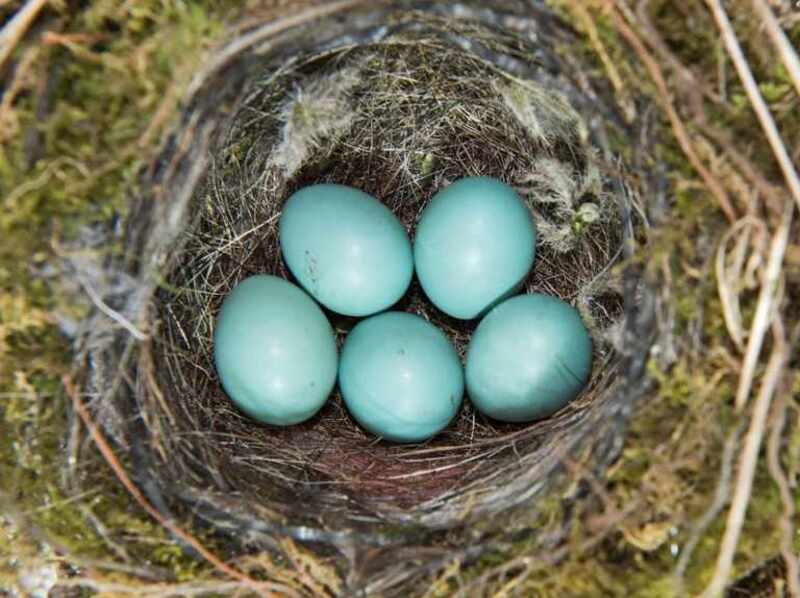
Blackbird
Blackbirds like to make their nest with mud, fine grass, and twigs. They will usually ay up to four broods a year. They can use this nest for each brood.
Blackbird Eggs: Appearance, and How Long Until They Hatch
Blackbird eggs are glossy with a greenish-blue color. Some of them even have red freckles. These eggs are about one inch long and 0.8 inches wide. Once hatched, a baby blackbird will fledge in two weeks. They can survive away from parents as young as nine days old. Most of the time, the male blackbird will take care of their babies until they’re ready to explore other food items. The females need to work up their energy to lay more eggs.

Pileated Woodpecker
The woodpecker with a bright-red crescent is hard to miss. This type of woodpecker loves to build their nest in large trees. Unlike many other birds, the Pileated Woodpecker will drill directly into a tree to make their nest. They create their own safe haven inside with wood chips. Their nests are sometimes two feet high once they finish. It sometimes takes up to six weeks for them to finish a nest.
Pileated Woodpecker Eggs: Appearance, and How Long Until They Hatch
Pileated woodpeckers have just one brood per season and lay between 3 and 5 eggs which are plain white in color. These eggs average about 1.4 inches long by one inch wide. The mama and daddy birds will take turns incubating these eggs. They take about 18 days to hatch. Once they are born, they don’t have any feathers.
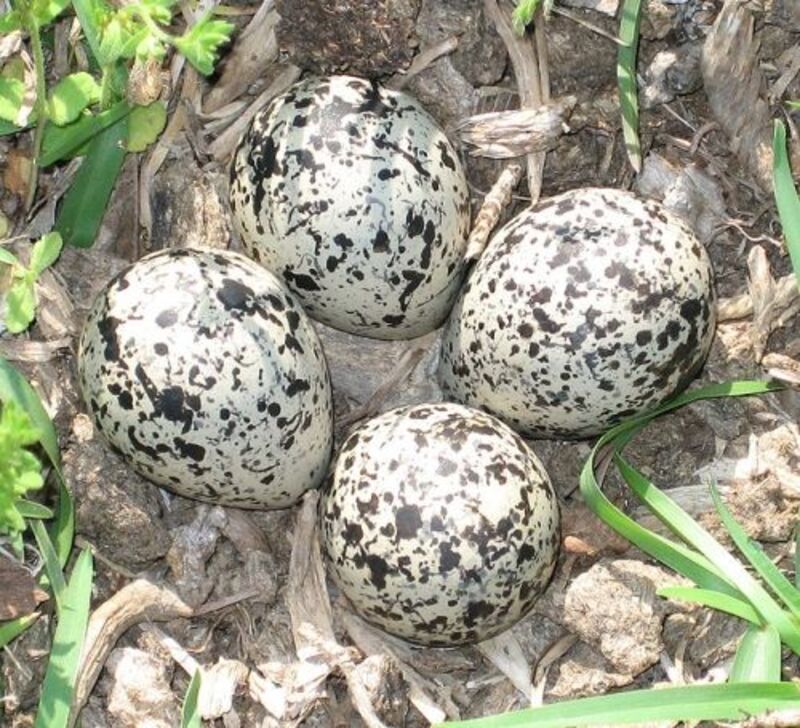
Killdeer
Killdeer like to nest on the open ground. Sometimes they will create a nest on gravel. These eggs are speckled helping them to blend in with their surroundings.
Killdeer Eggs: Appearance, and How Long Until They Hatch
These eggs are about 1.5 inches long and one inch wide. A killdeer egg will incubate for up to 28 days before the babies are ready to hatch. Once the killdeer hatches, it’s ready to hit the ground running. They come out with wide open eyes. Once their feathers dry, they’re ready to start following their parents to learn the ways of the world.
How Eggs Hatch
Many baby birds have special muscles and a “hatching tooth” that help the baby to move their head with enough force that cracks the egg open. Some stay in their nest for a little bit of time, while others stay nestled for months. Some birds like cranes and waterfowl are already ready to follow their mother around her land.
In Conclusion
There is no rhyme or reason for a hatchling’s incubation period. Many different species have varying times. In most species, it’s up to the female bird to sit on her nest keeping her babies warm and cozy. Most parents also stay with their hatched babies until they learn to fly.
Every bird is different in their own way. They each have their own special presence. They learn to survive and thrive after they hatch out of their egg. One thing about all of the bird species is that the mama bird always seem to protect her babies util they’re ready to face life on their own.
Related
- American Robins are fascinating birds. Explore their herd behavior in more depth: Do Robins Travel In Flocks?
- In the mood for a bit of birding lore? How about the bird equivalent of bigfoot? Read on in The Mythical Blue Cardinal.
As usual birds come to plants we hang under the patio roof . We have had this happen every spring for at least 15 yrs. I see three unhatched as of July seventh. The mother bird comes in with food stays a bit then fly’s away sit in a tree near bye and chirps. I think they will not hatch my wife feels this is normal but not, because in the past yrs they would have hatched. I have not touched nor bothered except to peak in. What is the answer to this?
I have baby eggs and in a nest and they have not hatched and what can I can do to help them.
I have got very small humming Bird egg the eggs are going to yellow colour what can I do?